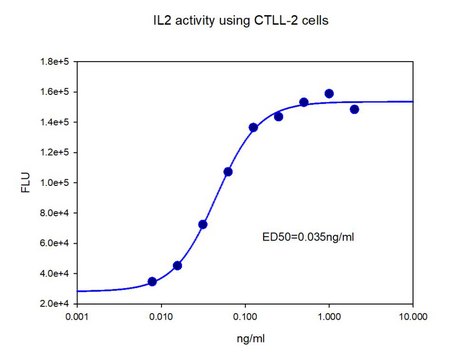SBR00013
Actinomycin D, Fertiglösung
from Streptomyces sp., 2 mg/mL in DMSO
Synonym(e):
Actinomycin D -Lösung aus Streptomyces sp., Actinomycin IV
About This Item
Empfohlene Produkte
Biologische Quelle
Streptomyces sp.
Qualitätsniveau
Beschreibung
Ready Made Solution
Form
liquid
Lagerbedingungen
protect from light
Konzentration
2 mg/mL in DMSO
Farbe
dark orange
Wirkungsspektrum von Antibiotika
neoplastics
Wirkungsweise
DNA synthesis | interferes
Lagertemp.
−20°C
InChI
1S/C62H86N12O16/c1-27(2)42-59(84)73-23-17-19-36(73)57(82)69(13)25-38(75)71(15)48(29(5)6)61(86)88-33(11)44(55(80)65-42)67-53(78)35-22-21-31(9)51-46(35)64-47-40(41(63)50(77)32(10)52(47)90-51)54(79)68-45-34(12)89-62(87)49(30(7)8)72(16)39(76)26-70(14)58(83)37-20-18-24-74(37)60(85)43(28(3)4)66-56(45)81/h21-22,27-30,33-34,36-37,42-45,48-49H,17-20,23-26,63H2,1-16H3,(H,65,80)(H,66,81)(H,67,78)(H,68,79)
InChIKey
RJURFGZVJUQBHK-UHFFFAOYSA-N
Suchen Sie nach ähnlichen Produkten? Aufrufen Leitfaden zum Produktvergleich
Anwendung
<li><strong>Regulation of Immune Checkpoints in Cancer:</strong> Actinomycin D is pivotal in studying the ADAR-mediated RNA editing processes that regulate PVR immune checkpoints in colorectal cancer, thus demonstrating its crucial role in cancer immunotherapy research and providing insights into novel therapeutic targets (Qian et al., 2024).</li>
<li><strong>Chemotherapy and Immunotherapy Combination:</strong> The use of Actinomycin D in combined chemotherapy highlights its effectiveness in salvaging multi-chemotherapy agent and avelumab resistant choriocarcinoma, showcasing its potential in overcoming resistance to treatment in gynecological cancers (Lehmann et al., 2023).</li>
<li><strong>Advancements in Dental Medicine:</strong> Actinomycin D is used in regulating gene expression crucial for tissue regeneration and repair in dental health and it is also used to determine RNA stability assay (Pan et al., 2023).</li>
<li><strong>Cancer Progression Research:</strong> The study on hypoxia-induced lncRNA in hepatocellular carcinoma progression, where RNA-binding proteins play a critical role, aligns with Actinomycin D′s application in transcriptional inhibition and its influence on mRNA stability, essential for understanding cancer biology and developing targeted therapies (Tuo et al., 2023).</li>
</ul>
Biochem./physiol. Wirkung
Actinomycin D has been shown to be an inhibitor of the minus-strand transfer step in reverse transcription, and is therefore used in studies and suppression of HIV-replication. It has also been shown to suppress programmed cell death of PC12 cells induced by etoposide, an inhibitor of topoisomerase II.
In cell culture, actinomycin D is used as a selection agent. Actinomycin D binding to yeast in ribosomal RNA has been studied. The sensitivity of various strains of E. coli to actinomycin D and the mechanism of binding has been studied. Actinomycin D is also used in molecular biology as a DNA intercalator which blocks the progression of RNA polymerases.
Verpackung
Vorsicht
Angaben zur Herstellung
Signalwort
Danger
H-Sätze
Gefahreneinstufungen
Carc. 1B
Lagerklassenschlüssel
6.1C - Combustible acute toxic Cat.3 / toxic compounds or compounds which causing chronic effects
WGK
WGK 3
Flammpunkt (°F)
188.6 °F - closed cup
Flammpunkt (°C)
87 °C - closed cup
Analysenzertifikate (COA)
Suchen Sie nach Analysenzertifikate (COA), indem Sie die Lot-/Chargennummer des Produkts eingeben. Lot- und Chargennummern sind auf dem Produktetikett hinter den Wörtern ‘Lot’ oder ‘Batch’ (Lot oder Charge) zu finden.
Besitzen Sie dieses Produkt bereits?
In der Dokumentenbibliothek finden Sie die Dokumentation zu den Produkten, die Sie kürzlich erworben haben.
Kunden haben sich ebenfalls angesehen
Unser Team von Wissenschaftlern verfügt über Erfahrung in allen Forschungsbereichen einschließlich Life Science, Materialwissenschaften, chemischer Synthese, Chromatographie, Analytik und vielen mehr..
Setzen Sie sich mit dem technischen Dienst in Verbindung.








